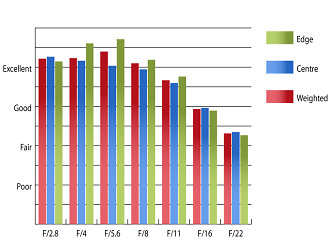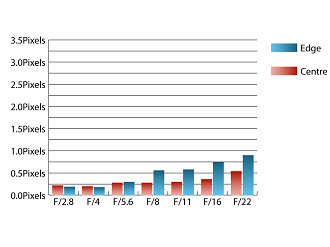Panasonic Lumix G 30mm f/2.8 Macro ASPH. Review
Panasonic Lumix G Macro 30mm f/2.8 Performance
At maximum aperture, sharpness is already excellent across the frame. Stopping down only results in an increase in performance towards the edges of the frame between f/4 and f/5.6.
How to read our charts
The blue column represents readings from the centre of the picture frame at the various apertures and the green is from the edges. Averaging them out gives the red weighted column.The scale on the left side is an indication of actual image resolution. The taller the column, the better the lens performance. Simple.
For this review, the lens was tested on a Panasonic Lumix GX7 using Imatest.
Chromatic aberrations are well controlled with fringing only exceeding half a pixel width as the aperture is stopped down to f/8 or beyond. This low level of fringing should pose few issues, even in images with high contrast towards the edges of the frame.
How to read our charts
Chromatic aberration is the lens' inability to focus on the sensor or film all colours of visible light at the same point. Severe chromatic aberration gives a noticeable fringing or a halo effect around sharp edges within the picture. It can be cured in software.Apochromatic lenses have special lens elements (aspheric, extra-low dispersion etc) to minimize the problem, hence they usually cost more.
For this review, the lens was tested on a Panasonic Lumix GX7 using Imatest.
Falloff of illumination towards the corners is fairly typical for fast aperture macro lens. At f/2.8 the comers are 1.6 stops darker than the centre of the image and stopping down to f/5.6 results in visually uniform illumination.
Distortion is extremely well controlled with only 0.863% pincushion distortion being present. This low level of distortion should rarely require correction, but if it does, the distortion pattern is uniform across the frame, which should make applying corrections in image editing software afterwards, relatively straightforward.
Shooting into the light is no problem for this optic as it is very resistant to flare and contrast is well retained when shooting into the light.
Value For Money
Priced at £300, this lens represents pretty good value for money, especially when the excellent performance and compact size are taken into account.
The nearest macro lens alternative, in terms of price is the Olympus 60mm f/2.8, which costs around £330, but lacks optical stabilisation.
Add your message
Please login here or if you've not registered, you can register here. Registering is safe, quick and free.
photodo Stats
428 MTF tests
74 in-depth photodo reviews
100+ users join each day
Help the lens community by reviewing or rating a lens today via our lens search
Latest Lens Reviews
- Chinon 28mm f/2.8 Vintage Lens Review
- Canon EF 70-200mm f/4L IS II USM Lens Review
- Samyang AF 85mm f/1.4 EF Review
- Sigma 70mm f/2.8 DG Macro Art Review
- Samyang AF 24mm f/2.8 FE Review
- Meike 50mm f/1.7 Review
- Tamron 70-210mm f/4 Di VC USD Review
- Lensbaby Burnside 35mm f/2.8 Review
- Asahi Super Takumar 50mm f/1.4 Review
- Asahi Super-Multi-Coated Takumar 135mm f/3.5 Review


